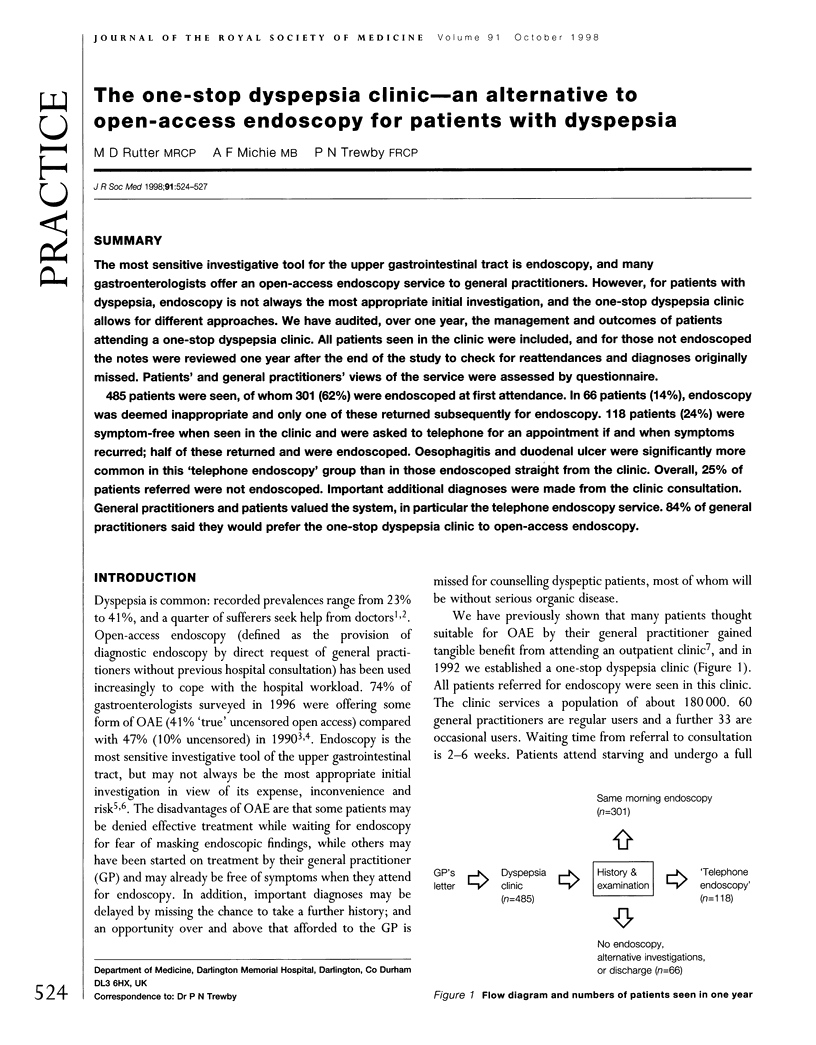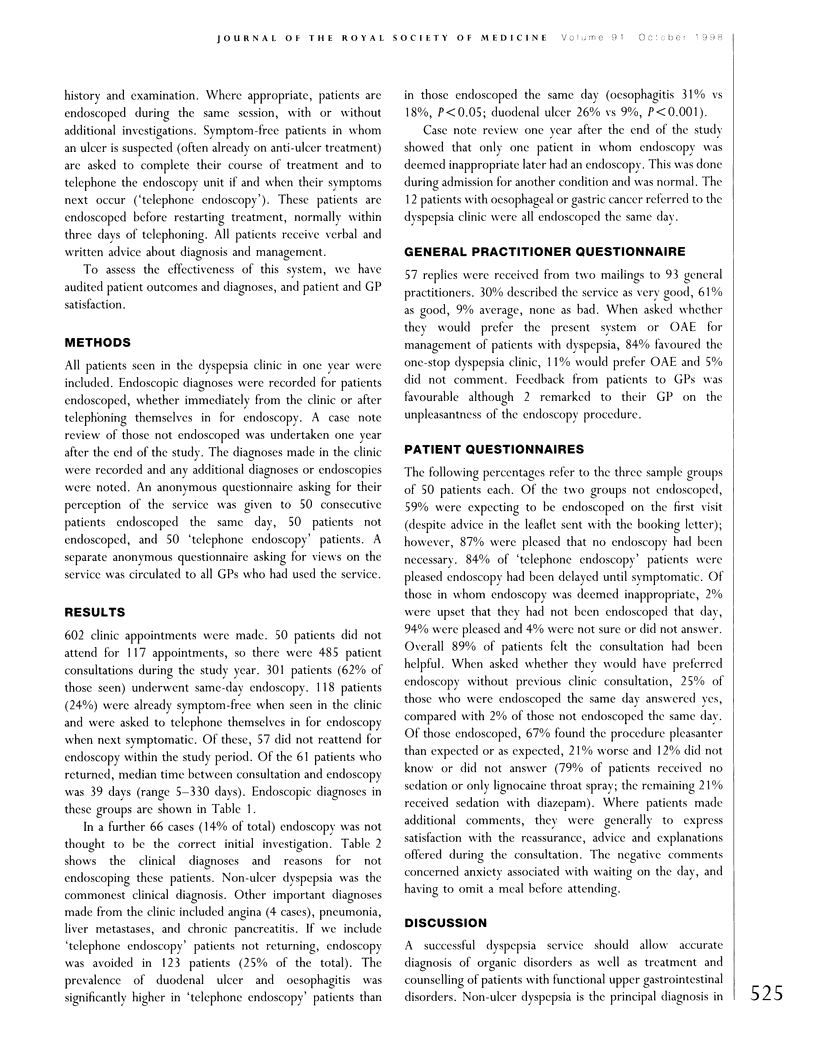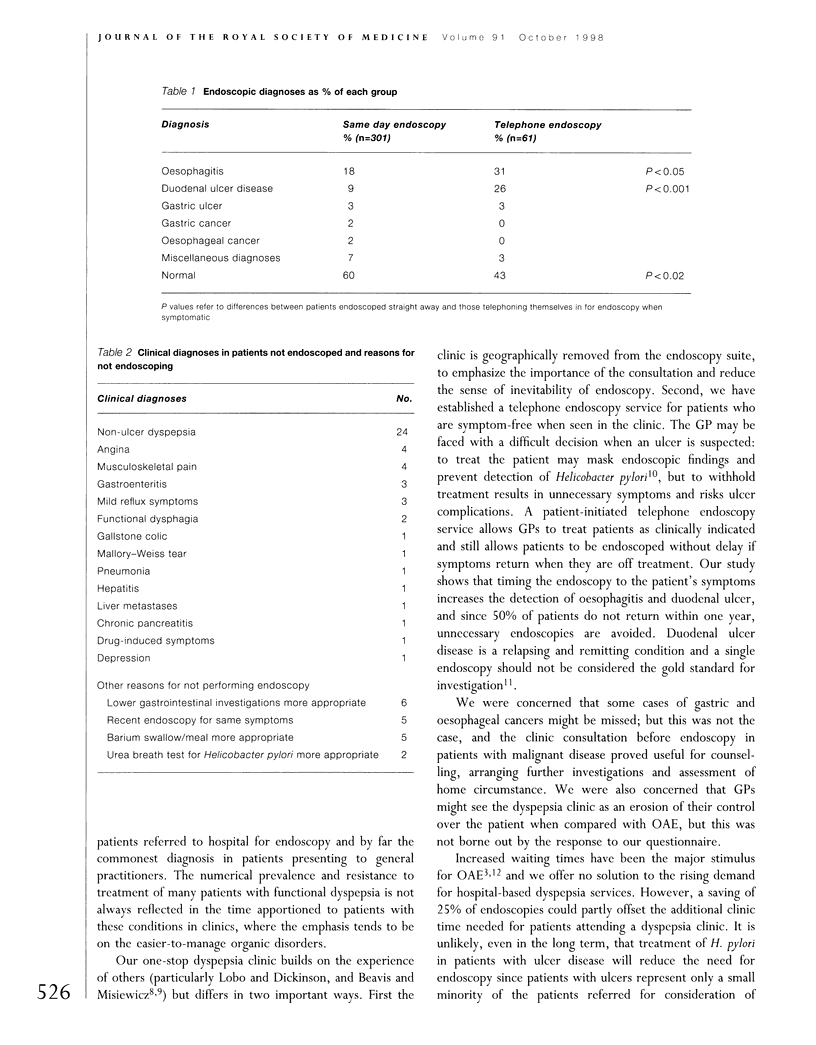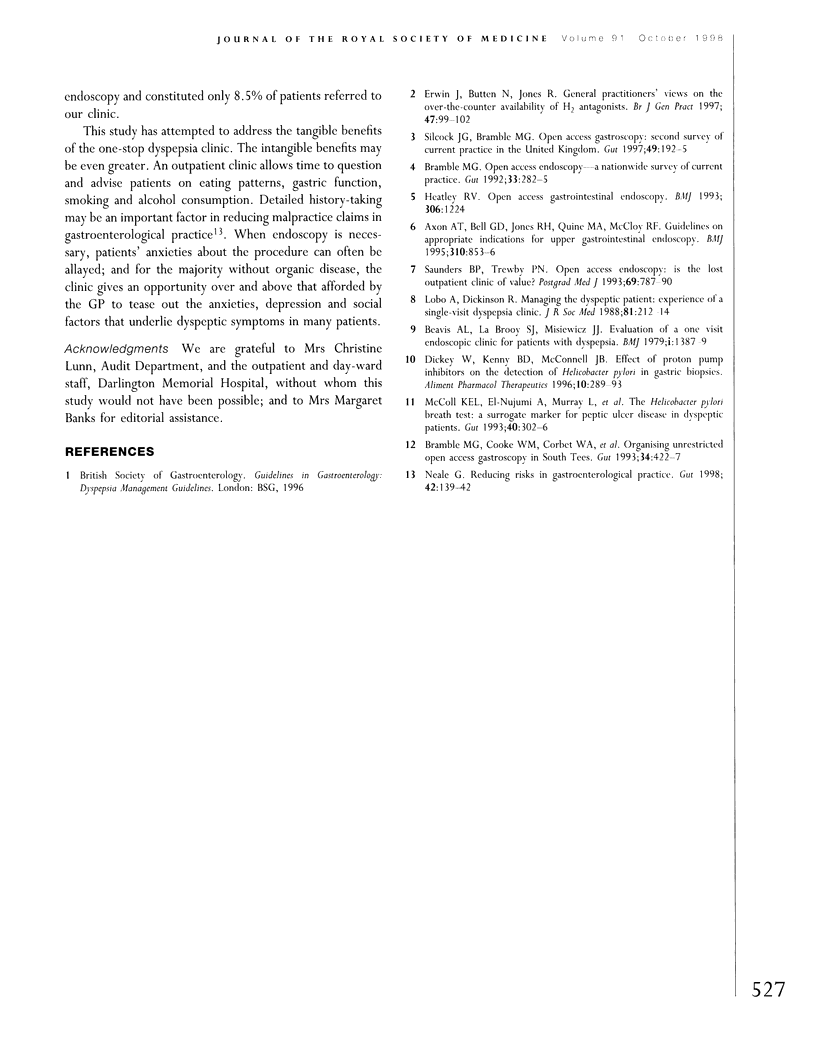Abstract
The most sensitive investigative tool for the upper gastrointestinal tract is endoscopy, and many gastroenterologists offer an open-access endoscopy service to general practitioners. However, for patients with dyspepsia, endoscopy is not always the most appropriate initial investigation, and the one-stop dyspepsia clinic allows for different approaches. We have audited, over one year, the management and outcomes of patients attending a one-stop dyspepsia clinic. All patients seen in the clinic were included, and for those not endoscoped the notes were reviewed one year after the end of the study to check for reattendances and diagnoses originally missed. Patients' and general practitioners' views of the service were assessed by questionnaire. 485 patients were seen, of whom 301 (62%) were endoscoped at first attendance. In 66 patients (14%), endoscopy was deemed inappropriate and only one of these returned subsequently for endoscopy. 118 patients (24%) were symptom-free when seen in the clinic and were asked to telephone for an appointment if and when symptoms recurred; half of these returned and were endoscoped. Oesophagitis and duodenal ulcer were significantly more common in this 'telephone endoscopy' group than in those endoscoped straight from the clinic. Overall, 25% of patients referred were not endoscoped. Important additional diagnoses were made from the clinic consultation. General practitioners and patients valued the system, in particular the telephone endoscopy service. 84% of general practitioners said they would prefer the one-stop dyspepsia clinic to open-access endoscopy.
Full text
PDF



Selected References
These references are in PubMed. This may not be the complete list of references from this article.
- Axon A. T., Bell G. D., Jones R. H., Quine M. A., McCloy R. F. Guidelines on appropriate indications for upper gastrointestinal endoscopy. Working Party of the Joint Committee of the Royal College of Physicians of London, Royal College of Surgeons of England, Royal College of Anaesthetists, Association of Surgeons, the British Society of Gastroenterology, and the Thoracic Society of Great Britain. BMJ. 1995 Apr 1;310(6983):853–856. doi: 10.1136/bmj.310.6983.853. [DOI] [PMC free article] [PubMed] [Google Scholar]
- Beavis A. K., La Brooy S., Misiewicz J. J. Evaluation of one-visit endoscopic clinic for patients with dyspepsia. Br Med J. 1979 May 26;1(6175):1387–1389. doi: 10.1136/bmj.1.6175.1387. [DOI] [PMC free article] [PubMed] [Google Scholar]
- Bramble M. G., Cooke W. M., Corbett W. A., Cann P. A., Clarke D., Contractor B., Hungin A. S. Organising unrestricted open access gastroscopy in South Tees. Gut. 1993 Mar;34(3):422–427. doi: 10.1136/gut.34.3.422. [DOI] [PMC free article] [PubMed] [Google Scholar]
- Bramble M. G. Open access endoscopy--a nationwide survey of current practice. Gut. 1992 Feb;33(2):282–285. doi: 10.1136/gut.33.2.282. [DOI] [PMC free article] [PubMed] [Google Scholar]
- Dickey W., Kenny B. D., McConnell J. B. Effect of proton pump inhibitors on the detection of Helicobacter pylori in gastric biopsies. Aliment Pharmacol Ther. 1996 Jun;10(3):289–293. doi: 10.1111/j.0953-0673.1996.00289.x. [DOI] [PubMed] [Google Scholar]
- Erwin J., Britten N., Jones R. General practitioners' views on the over-the-counter availability of H2-antagonists. Br J Gen Pract. 1997 Feb;47(415):99–102. [PMC free article] [PubMed] [Google Scholar]
- Heatley R. V. Open access upper gastrointestinal endoscopy. BMJ. 1993 May 8;306(6887):1224–1224. doi: 10.1136/bmj.306.6887.1224. [DOI] [PMC free article] [PubMed] [Google Scholar]
- Lobo A., Dickinson R. Managing the dyspeptic patient: experience of a single-visit dyspepsia clinic. J R Soc Med. 1988 Apr;81(4):212–213. doi: 10.1177/014107688808100409. [DOI] [PMC free article] [PubMed] [Google Scholar]
- McColl K. E., el-Nujumi A., Murray L., el-Omar E., Gillen D., Dickson A., Kelman A., Hilditch T. E. The Helicobacter pylori breath test: a surrogate marker for peptic ulcer disease in dyspeptic patients. Gut. 1997 Mar;40(3):302–306. doi: 10.1136/gut.40.3.302. [DOI] [PMC free article] [PubMed] [Google Scholar]
- Neale G. Reducing risks in gastroenterological practice. Gut. 1998 Jan;42(1):139–142. doi: 10.1136/gut.42.1.139. [DOI] [PMC free article] [PubMed] [Google Scholar]
- Saunders B. P., Trewby P. N. Open access endoscopy: is the lost outpatient clinic of value? Postgrad Med J. 1993 Oct;69(816):787–790. doi: 10.1136/pgmj.69.816.787. [DOI] [PMC free article] [PubMed] [Google Scholar]
- Silcock J. G., Bramble M. G. Open access gastroscopy: second survey of current practice in the United Kingdom. Gut. 1997 Feb;40(2):192–195. doi: 10.1136/gut.40.2.192. [DOI] [PMC free article] [PubMed] [Google Scholar]


